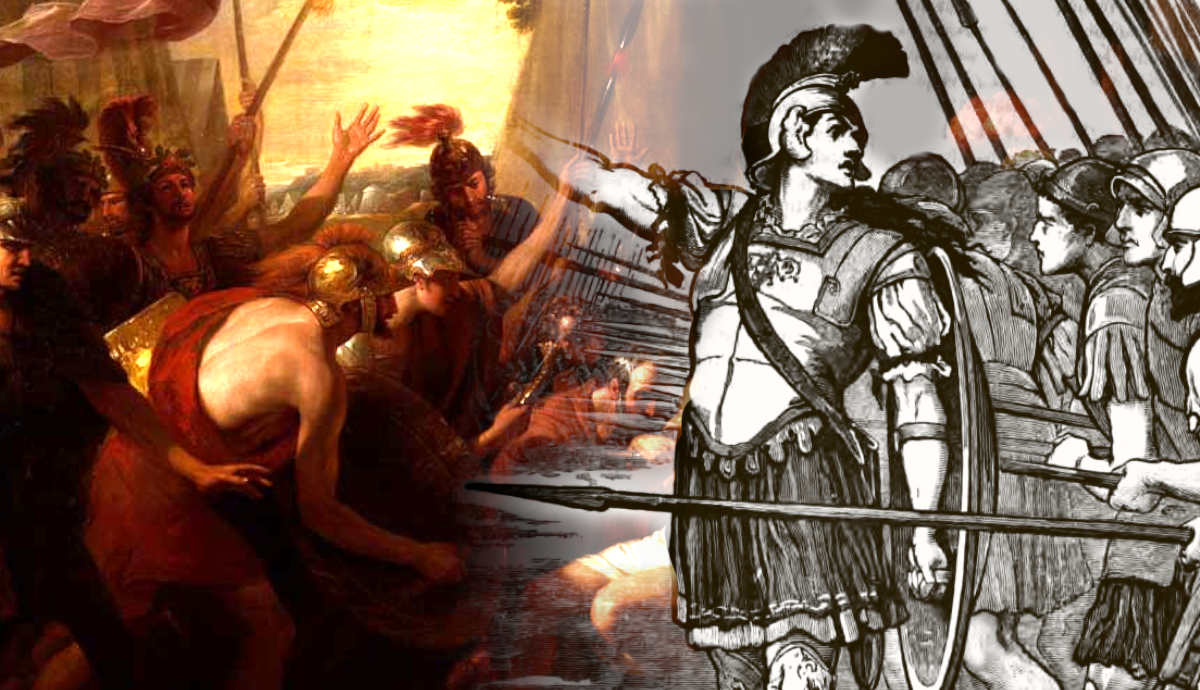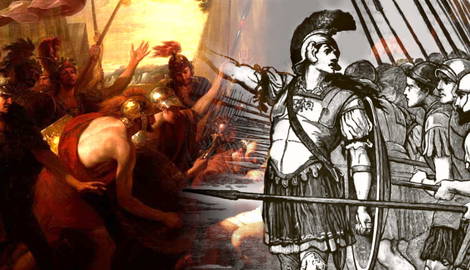
For centuries, classical Greece was dominated by conflicts between city-states, as well as invasions from Persia. Throughout this time, Sparta maneuvered itself militarily to eventually become the dominant power in Greece. Spartan hoplites, bred from birth for the single purpose of being soldiers, solidified their reputation through their actions at Thermopylae, Plataea, and the Peloponnesian War.
Spartan soldiers attained legendary status as almost invincible, and none dared challenge them. But with all things in Greek antiquity, “hubris” played its hand. The mythical prowess of Spartan hoplites was eventually challenged by the city-state of Thebes. And at a place called Leuctra, they were put to the test.
Background to the Battle of Leuctra

The Battle of Leuctra was the end result of a series of events that played out for over half a century. From 431 BC to 404 BCE, much of Greece was embroiled in a conflict known as the Peloponnesian War between the Delian League led by Athens and the Peloponnesian League led by Sparta. The result was a victory for Sparta, setting the stage for the Spartan hegemony over the Greek world for decades to come.
The Spartan hegemony, however, would not go unchallenged. Those that Sparta had subjugated were mistreated, and Sparta’s allies, who had done much of the fighting received nothing for their troubles. Eventually, Sparta’s former allies of Corinth and Thebes formed a coalition with Argos and Athens and attempted to throw off the Spartan yoke in 395 BCE.
The Corinthian War, as it was known, swayed back and forth with Sparta winning land battles, but losing to the Athenians at sea. The war eventually ended inconclusively with a peace in 387 BCE that still left Sparta as the dominant power in Greece.
The Boeotian War
1. The Struggle for Thebes

After the Corinthian War, Sparta continued its hegemony and punished those who had stood in its way. The city-state of Mantinea, a Spartan ally, was the first to feel Sparta’s wrath. Sparta accused Mantinea of failing to fulfill its obligations as a Spartan ally and used military power to force Mantinea back into line. The next target was the city of Olynthus in the north of Greece, whom Sparta accused of not fulfilling the terms of the treaty that ended the Corinthian War.
As the Spartan army under the command of Phoebidas marched through Boeotia, Leontiades — one of the leaders of the Theban oligarchic party — asked the Spartans to intervene in Thebes and take control of the citadel, as Leontiades felt threatened by the democratic party in Thebes. The Spartans sided with the oligarchs and took control of Thebes, effectively occupying it and breaking the treaty that ended the Corinthian War. The Theban democrats, under Pelopidas, fled the city to Athens. From there, they mounted an effective resistance campaign to take back the city. They were able to assassinate the oligarchic opponents and rouse the city’s populace which overpowered the Spartan garrison and retook control of Thebes.
2. Thebes Takes the War to Sparta

This kickstarted another war in which Sparta sought to stamp its dominance on Greece. In the winter of 378 BCE, the Spartans immediately sent out an army under one of its kings, Cleombrotus. They decimated a force of Theban democrats that stood in their way and then made camp several miles outside the city of Thebes. Realizing their poor position, the Thebans attempted a diplomatic resolution, but the Spartans rejected their overtures.
Athens, which had been reluctant to take any sides, attempted to remain neutral. Still, an attempted raid by the Spartans on the Athenian port of Peiraeus forced Athens to declare war on Sparta.
In 378 BCE and 377 BCE, the Spartans campaigned in Boeotia, attempting to take Thebes. There was intermittent raiding and skirmishing, but apart from Phoebidas being killed, the fighting failed to produce any significant change in the status quo.
In 376 BCE, the Thebans were strong enough to take the fight to the Spartans and captured virtually all Spartan holdings in Boeotia. With few options available, the Spartans attempted to take the fight to the Athenians via naval action. However, they were defeated by the larger Athenian fleet. This opened the door to the heartland of Laconia, and the Athenians managed to attack Spartan assets close to Sparta itself.
3. The Road to Leuctra

An attempted peace treaty fell through when the Theban leader Epaminondas demanded signing the treaty on behalf of all Boeotia, not just Thebes. The Spartans took offense at this action and refused the peace deal. Thebes and Sparta once again prepared for war.
On July 6, 371 BCE, the Spartans marched for the last time on Thebes. Despite being outnumbered and outclassed by the Spartan army, the Thebans gathered to battle and met the Spartans at a place called Leuctra, a mere 10 miles to the southwest of Thebes. The ensuing Battle of Leuctra would go down as a defining moment in the history of Greece.
The Battle of Leuctra

The Spartan army numbered between 10 000 and 11 000 hoplites, hardened by intense training and years of war. They were supported by 1000 cavalry. Leading them was the Spartan king Cleombrotus.
First, they marched on the Theban fort of Creusis, capturing it along with 12 Theban warships. The Thebans were caught by surprise, and the generals were divided as to whether they should offer battle. The Theban general Epaminondas argued for giving the Spartans a fight, despite the shaky loyalty of the allied troops within the Theban-led army.
1. Epaminondas’ Gamble

The Thebans and their allies marched out and encountered the Spartan army at Leuctra. Like the Spartan army, the Theban army was a mixture of allies from different city-states. With the total number of hoplites numbering 6 000 to 7 000, and with 2 000 cavalry, it was clear that the Thebans would have to do something spectacular if they were to win. Epaminondas, however, had an idea. It would be a gamble, and if it failed, it would result in a defeat from which Thebes would not recover. He knew the Battle of Leuctra would be the linchpin on which Sparta or Thebes would reign supreme over much of Greece.
The military doctrine of the day was to put the strongest, most battle-hardened troops on the right flank. This provided a guide for other troops to follow and ensured that the battle line did not wheel to the left while marching forward. True to form, this is how the Spartans deployed for battle at Leuctra.

Epaminondas, expecting this formation, decided to place the vast bulk of his army and his elite troops — the famed Sacred Band of Thebes — on his left flank to directly counter the strongest Spartan hoplites. This, however, would mean his weaker troops would be easily overpowered once they engaged the enemy. So, he arrayed the army in oblique order, and in echelon formation to keep them from engaging the enemy for as long as possible. Their slow advance meant the rest of the Spartan army would be occupied waiting for the clash and thus unable to reinforce their right flank, which would come under heavy pressure.
The Spartans did not put great emphasis or thought into the usage of cavalry, and the battle started with a cavalry skirmish between the two armies. The Thebans, with numerical superiority and with more prowess on horseback, easily dispatched the Spartan cavalry, which fled back through the Spartan infantry lines, momentarily breaking the cohesion of the Spartan forces.
2. Thebes Overpowers Sparta

Meanwhile, Epaminondas advanced his left flank and engaged the strong right flank of the Spartan line. The Theban left flank connected head-on with the Spartan right flank, and the two sections began a furious struggle as shields collided and spears probed the gaps, inflicting mortal wounds.

The weight of the Theban numbers pushing from behind forced the Thebans forward, and the Spartan elite started buckling under the pressure. King Cleombrotus, in the thick of the fighting, was felled. The loss of their leader caused the Spartans and their allies to lose morale, and they quickly began losing hope of victory. As the Spartan right flank fell back, the exposed right flank of the rest of the army allowed the Thebans to pour in and start destroying the Spartan line in detail. Defeat for the Spartans was assured and they broke and fled.
There are wildly different accounts of the casualties and losses of the battle, but it is believed that the Spartans lost over a thousand men while the Thebans suffered a few hundred.
What Happened to Sparta After the Battle of Leuctra?

The Battle of Leuctra served as a critical action whereby Spartan hegemony was severely threatened, and Thebes ascended to become the hegemon of Greece. A decade later, Epaminondas would liberate much Spartan territory, once again defeating a larger Spartan army at Mantinea (362 BCE), ensuring the eclipse of Sparta as a powerful city-state. Sadly for Epaminondas, Mantinea would be his last engagement, as he was killed while pursuing the fleeing Spartans.
Mantinea was a Theban victory but a pyrrhic one. The Theban army was subsequently weakened following the battle. Even though Thebes managed to briefly maintain its dominance over Greece, the Theban hegemony would be short-lived. Soon a new power would rise in the North and take Greece and the whole known world by storm: the kingdom of Macedon.
Battle of Leuctra: Conclusion

The Battle of Leuctra smashed the myth of Spartan invincibility. It changed the power dynamic throughout Greece and ensured that Thebes would overtake Sparta as the dominant power.
The tactics used by Epaminondas also serve as a lesson to military analysts. The inflexibility of the Spartans and their reticence in expecting dynamic shifts in military thinking was the cause of their downfall. In short, the Spartans were not just defeated by the Thebans but their own hubris.











